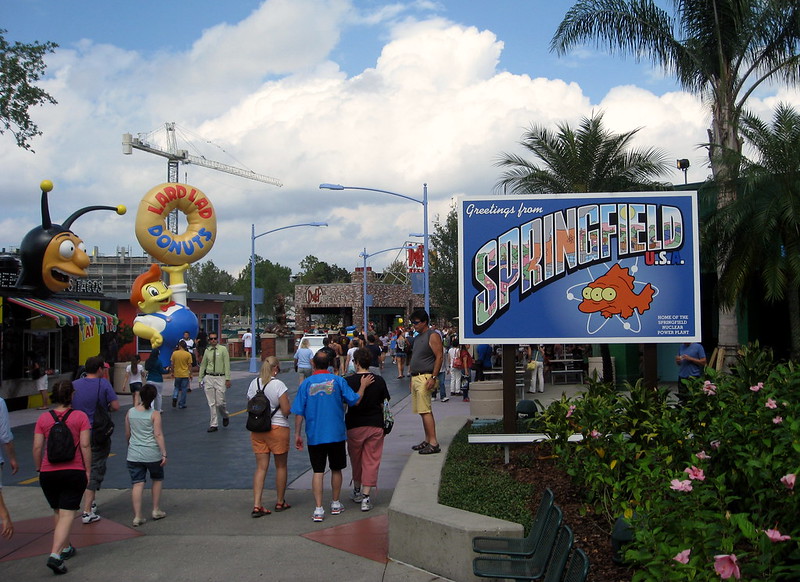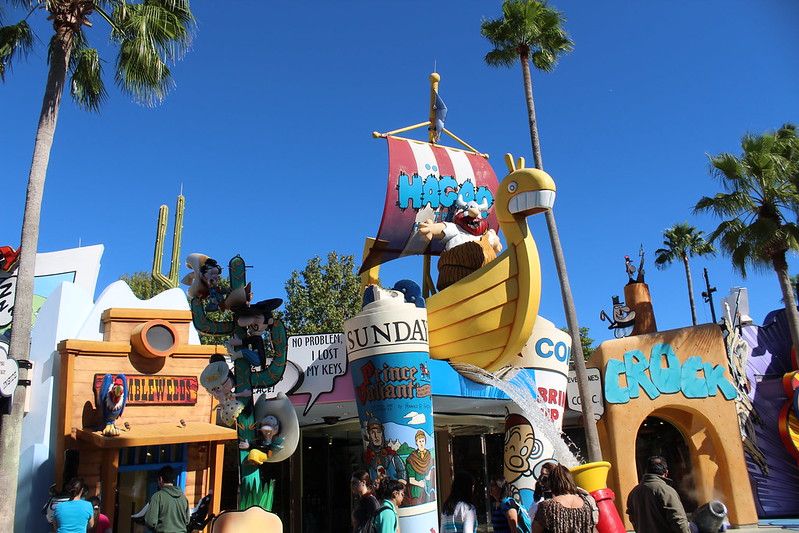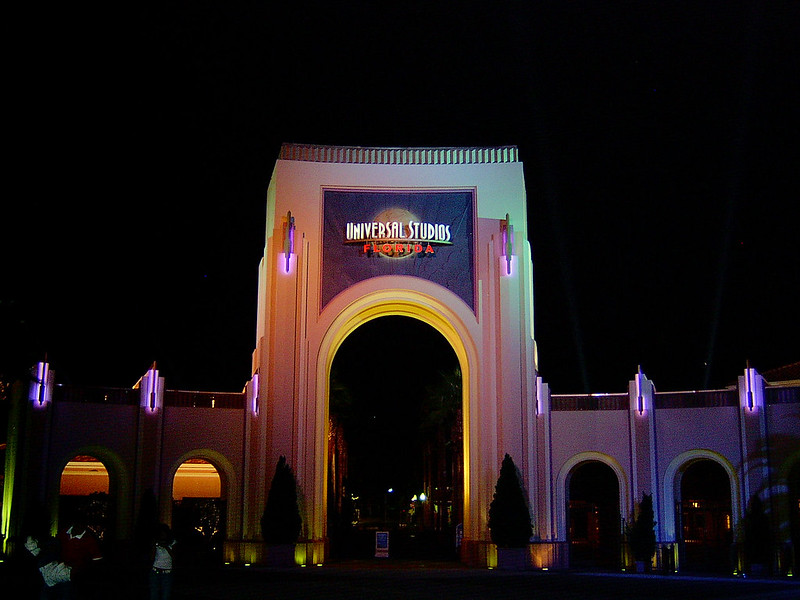The Simpsons End Credits Theme (Hill Street Blues Homage) - Springfield

The Simpsons brought order to a stretch of Universal Studios Florida that had previously known only chaos.
World Expo was a free-for-all from day one, when it was called the somehow more generic Expo Center. No city sets to fall back on. Not even a clear purpose like Production Central. In the designers’ defense, how else do you connect the E.T. Adventure, two sets from Psycho IV, a Hard Rock Café, and the still-unbuilt Back to the Future: The Ride?
Beyond the Institute of Future Technology and a cafeteria that served mall Chinese food, the concept of a world’s fair didn’t hold much water. In 1999, everything but the lagoon-front property seceded into Woody Woodypecker’s Kidzone. A number of the attractions intended for the prime real estate occupied by Swamp Thing sets could’ve fit the theme - an Apollo 13 roller coaster housed in a replica of Kennedy Space Center’s Vehicle Assembly Building was the best fit - but it took 2000’s Men in Black: Alien Attack to actually make it work. At least, for a while.
Back to the Future: The Ride closed in 2007 to be replaced by The Simpsons Ride in 2008. The International Food and Film Festival lasted four years after that as a strangely strait-laced food court for Krustyland.
In the summer of 2013, the last original stretch of Expo became Springfield, Home of the Springfield Nuclear Power Plant. It finally had character, and how.
Simpsons fans could spend the better part of a day squinting out the jokes in Fast Food Boulevard alone. The Duff Beer flows daily and, unlike in the show, from a different tap than the Duff Lite and Duff Dry. So many visitors leaned on Chief Wiggums all-black squad car for a photo-op that the resulting burns forced Universal to repaint it white. London across the water may be a grander sight, but in all its tiniest details, Springfield feels like it’s always been around.
The soundtrack loop is a quiet reminder that the show, for all intents and purposes, has always been around. One-off renditions of Danny Elfman’s unmistakable theme intermingle with the original and none mark the passage of time better than series composer Alf Clausen’s send-up of Hill Street Blues.
In the sixth season episode, “The Springfield Connection,” matriarch Marge joins the local police force in an adequately veiled attempt to reference as much cop media as possible, including the 98-times-Emmy-nominated Hill Street Blues. Not even TV theme song maestro Mike Post was spared. Clausen translated filtered the usual end credits music through Post’s iconic Hill Street lilt and made one of the gentlest pieces of music in the show’s 30-plus seasons.
Anyone unfamiliar with the parody can still spot it by the horns and Local-On-The-Eights tranquility. The theme may only last about 40 seconds but hearing it over your beverage of choice while lounging down by the lagoon is as close as a day at Universal gets to therapy.
Toon Walk - Toon Lagoon

Toon Lagoon gets a bum rap.
When Islands of Adventure was originally conceived in the mid-90s, Jay Ward’s stable of off-kilter characters was enjoying a home video renaissance. Rocky and Bullwinkle enjoyed their own show over at the Studios. A simple Boris Badenov animatronic was even built into a third story window above the current Film Vault. Popeye has always enjoyed a similar popularity to Betty Boop - guaranteed to move merchandise despite no new developments with the character in the last half century - so nabbing his rights by way of the King Features Syndicate library was another obvious slam dunk.
Dinosaurs never go out of style. Marvel superheroes miraculously appreciated in value. Dr. Seuss seems to exist apart from time as we know it. But now Dudley Do-Right, Wossamotta U, and Popeye’s extended family have all seen better days.
Some of that’s inherent in the design. Outside of Ripsaw Falls and the Sweet Haven cul-de-sac, Toon Lagoon is an environment built entirely in the abstract. It’s as cohesive and dimensional as a stack of Sunday Funnies. The flatness of it all, down to Dudley Do-Right’s budget-cut figures, only took more heat as the years turned to decades and cutting-edge neighbors moved in across the pond.
In its defense, however, the Lagoon has atmosphere to spare. It is the ur-cartoon, the fundamental text of all animated tomfoolery and its maximalist sum. It’s equal parts translation and expression, about as detailed as a mission statement like this can get. If the Springfield faithful can lose an afternoon on those easter eggs, students of the ‘toon could spend several days on the Island and not notice everything. It helps to have a catchy soundtrack for the snooping.
“Toon Walk” was written by Chip Smith and Tony Humecke, a team of musicians that handled most of the park’s sillier songs. What sets it apart from the other nearby noise is its originality. Without directly aping a single cartoon, it sounds like every cartoon. It’s all squealing brass and twinkling piano, played with the kind of bounce that makes silly walks all but infectious.
“The Funny Business,” by decorated Broadway composer Andrew Lippa, is a similarly superb tone piece for Toon Lagoon and some discerning ears may prefer it, but it doesn’t quite have the squish or stretch of “Toon Walk.” The former sounds like the greatest golden age cartoon never made. The latter makes the listener feel like they’re inside it.
Will and Anna - Universal Studios Florida Front Gate

Every theme park worth its salt has a weepy closing number for the end of the day and it doesn’t get much weepier than the score to a Richard Curtis romantic comedy.
Notting Hill won a BAFTA Award for Most Popular Film in 2000. It was nominated for three Golden Globes. The soundtrack, including two tracks of Trevor Jones’s heartstringy score, beat out The Matrix, Fight Club, and Star Wars Episode I: The Phantom Menace for a Brit Award, the most prestigious pop music honor in the UK.
And yet most Universal guests would be hard-pressed to place it as it croons from the speakers. There’s more obscure music in the mix - an ethereal chorus from Conrad Pope’s Pavilion of Women score wins that race - but nothing so understated.
It lasts barely a minute. Unless you stop to tie your shoe on one of the planters at the right moment, you’ll miss it entirely. The only giveaway, before the band strikes up, is the lonely acoustic guitar that starts it off. Some of the other samples are mysterious, even ominous, but “Will and Anna” is distinctly downbeat.
Though it was intended to illustrate the mismatched love of Hugh Grant and Julia Roberts, it doubles beautifully for the exhausted melancholy of leaving a theme park. It’s a welcome end - the promise of a fast-approaching hotel room - with a tragic question mark - when will you next pass below the studio gates? It has the sweeping, wistful sadness of a perfect date that makes the sight of an unmarked calendar too much to bear. “Will and Anna” might play all day long, but when night falls and the crowd thins and all that’s left is the emporium and the parallel palms, it’s absolute poetry.
From Back to the Future to Notting Hill, the perfect bookends to a perfect Universal vacation.

Add new comment